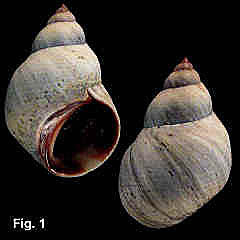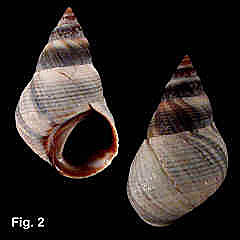|
|
|
|
|
Austrolittorina unifasciata (Gray, 1826) Description: Shell variable in height to width ratio. Whorls rounded, body whorl weakly angled at periphery. Sculptured with 10-12 fine spiral grooves above periphery and weaker spirals on base; whole surface with secondary microscopic spiral grooves. Columella smooth; outer lip thin, usually with microscopic lirae just within margin. Colour blue-grey, lighter on upper half of whorls and base. Apex brown, second and third spire whorls with brown spiral lines. Columella brown, aperture brown with white band internally near base. Operculum corneous. Size: Up to 24.9 mm in length, usually less than 15 mm; larger on Lord Howe Island, where individuals over 15 mm are common. Distribution: Endemic to Australia; Yeppoon, Queensland, around southern Australia to North West Cape, WA, including Tasmania and Lord Howe Island Habitat: Lives on hard surfaces on exposed and semi-exposed coasts. On exposed coasts adults occur in open positions and in pits and crevices from above the highest tide level down to the barnacles around mid-tide, with juveniles lower down among the barnacles. On sheltered shores it extends down to almost low tide level. Abundant. Synonymy: Numerous synonyms, including Littorina diemenensis Quoy & Gaimard, 1833 Remarks: This species has been described in detail by Reid & Williams (2004). This littorinid is one of the most common molluscs on rocky shores in southern Australia, sometimes occurring at densities of thousands per square metre. It is remarkably tolerant of a harsh environment, living exposed to the full heat of the summer sum and the cold of winter, from southern Queensland to southern Tasmania. In this species, fertilization is internal, the male transferring sperm to the female with a large penis on the right side of the head. The female releases egg capsules into the sea, each containing a single fertilized egg. The egg capsules were reported by Rudman (1996) to be transparent, domed, circular structures of 0.24 mm diameter, containing an egg 0.1 mm in diameter. After some time in the plankton, veliger larvae hatch from the egg capsule and eventually settle out on the shore. Large concentrations of settling juveniles suffer high mortality due to competition for food, which is microalgae, sporelings of macroalgae, and lichens. With growth, animals move upshore to the limit of their physiological tolerance to take advantage of reduced competition for food,. Laboratory experiments have shown that larger animals are more tolerant to high temperatures and low humidity, and field trials show that they return to the upper level if moved to a lower level near the high tide mark (Branch & Branch, 1981; Chen & Richardson, 1987; Reid & Williams, 2004). Fig. 1: North Freshwater, NSW (C.089573) Fig. 2: Berry Island, Sydney Harbour, NSW (C.356418) |

